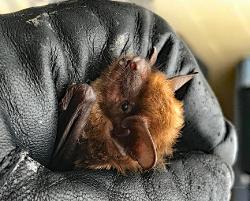
BATS
Bat Facts
Bats can be the hardest animal to remove in our wildlife pest control. There ability to fly combined with a small body allows them to enter a building anywhere there is hole that you are able to squeeze your pinky finger into.
Big brown bats and small brown bats are the two common species that inhabit buildings in Ottawa area. Big Browns are more common in urban areas, and small brown bats are more commonly removed from rural homes. It is difficult to distinguish the two apart other than a slight size difference and small brown bat colonies tend to be larger in numbers. Both species give birth to one baby per year, which can double the colony size in just one year.
Small brown bats migrate too hibernate during the winter, but will always return to the same building the following year. Big brown bats stay and overwinter/hibernate within the same building. Bats do not live by themselves, but live in colonies of around 20 all the way up into the hundreds. If you find a bat in your house throughout the winter, it would be safe to say that you have a colony of bats living somewhere in your house.
Bat colonies are not alway found living in the attic as most people believe. It is common to find them roosting in exterior walls, inbetween floors, in the soffit and in chimneys.
Common Concerns
Common concerns with a bat infestation are damage and odour caused by the considerable accumulation of urine and droppings in the attic, on your ceiling or in the exterior walls behind the drywall. Others are the possibility of histoplasmosis in the droppings and the exposure too potentially rabid bats.
Bat Removal and Control
When removing bats from a home, cottage or attic, considerable attention must be paid to sealing up absolutely every hole and gap on the exterior of the building. Missing even one little hole anywhere around the outside will allow the bats back in. This includes capping chimneys, screening roof vents and wall vents. Bats commonly target brick houses because there is normally a gap between the brick exterior and the soffit (overhang) of the house allowing them to gain access into the attic, soffit or behind the brick exterior. They also will enter through weeping holes in the brick.
Once all of the caulking and sealing is completed (except for the main entry holes), we then install special bat one-way doors in front of there main entry points which allows the colony of bats to leave at night to feed, preventing them from re-entering. We return after a couple of weeks to remove those bat doors and permanently seal the main entry holes.
During baby season, bats can not be removed because only half of the colony leaves at night to feed. The remaining half nurses the baby bats. Special attention must be paid around baby season to know when the young are able to fly and exit the house to ensure the entire colony is removed.